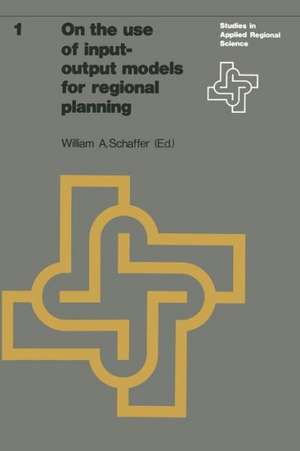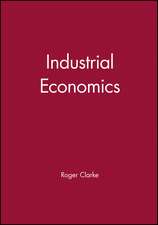On the use of input-output models for regional planning: Studies in Applied Regional Science, cartea 1
Editat de William Shaferen Limba Engleză Paperback – 31 iul 1976
Din seria Studies in Applied Regional Science
-
 Preț: 382.75 lei
Preț: 382.75 lei - 15%
 Preț: 636.45 lei
Preț: 636.45 lei -
 Preț: 378.71 lei
Preț: 378.71 lei -
 Preț: 378.34 lei
Preț: 378.34 lei - 15%
 Preț: 642.03 lei
Preț: 642.03 lei - 15%
 Preț: 639.90 lei
Preț: 639.90 lei - 15%
 Preț: 643.99 lei
Preț: 643.99 lei - 18%
 Preț: 947.04 lei
Preț: 947.04 lei - 15%
 Preț: 644.49 lei
Preț: 644.49 lei -
 Preț: 382.75 lei
Preț: 382.75 lei -
 Preț: 380.07 lei
Preț: 380.07 lei -
 Preț: 381.21 lei
Preț: 381.21 lei -
 Preț: 358.56 lei
Preț: 358.56 lei - 15%
 Preț: 645.60 lei
Preț: 645.60 lei -
 Preț: 376.80 lei
Preț: 376.80 lei -
 Preț: 378.92 lei
Preț: 378.92 lei -
 Preț: 381.00 lei
Preț: 381.00 lei -
 Preț: 378.34 lei
Preț: 378.34 lei -
 Preț: 379.48 lei
Preț: 379.48 lei - 15%
 Preț: 633.53 lei
Preț: 633.53 lei -
 Preț: 386.39 lei
Preț: 386.39 lei
Preț: 382.36 lei
Nou
Puncte Express: 574
Preț estimativ în valută:
73.17€ • 78.24$ • 61.00£
73.17€ • 78.24$ • 61.00£
Carte tipărită la comandă
Livrare economică 18 aprilie-02 mai
Preluare comenzi: 021 569.72.76
Specificații
ISBN-13: 9789020706260
ISBN-10: 9020706268
Pagini: 196
Ilustrații: 188 p.
Dimensiuni: 155 x 235 x 10 mm
Greutate: 0.28 kg
Ediția:Softcover reprint of the original 1st ed. 1976
Editura: Springer Us
Colecția Springer
Seria Studies in Applied Regional Science
Locul publicării:New York, NY, United States
ISBN-10: 9020706268
Pagini: 196
Ilustrații: 188 p.
Dimensiuni: 155 x 235 x 10 mm
Greutate: 0.28 kg
Ediția:Softcover reprint of the original 1st ed. 1976
Editura: Springer Us
Colecția Springer
Seria Studies in Applied Regional Science
Locul publicării:New York, NY, United States
Public țintă
ResearchCuprins
1. Introduction.- 1.1 Purpose.- 1.2 Significance of the Georgia Economic Model.- 1.3 Organization of this book.- 2. The Logic of Input-Output Models.- 2.1 Introduction.- 2.2 The state transactions table.- 2.3 The rationale for a model: analysis vs. description.- 2.4 Preparing the transactions table: closing with respect to households.- 2.5 The economic model.- 2.6 Economic change in input-output models.- 3. Constructing the Transactions Table.- 3.1 General approach.- 3.2 Local- and primary-data sources.- 3.3 Secondary-data sources.- 3.4 The estimating procedure.- 4. Input-Output Relations in the Georgia Economy.- 4.1 Introduction.- 4.2 Final demand.- 4.3 Final payments.- 4.4 Interindustry transactions.- 4.5 Income and product accounts for Georgia, 1970.- 4.6 Summary.- 5. Economic Multipliers for Georgia Industries.- 5.1 Introduction.- 5.2 The multiplier concept.- 5.3 Output and employment multipliers.- 5.4 Household-income multipliers.- 5.5 Government-income multipliers.- 5.6 Industry contributions to the Georgia economy.- 6. Economic Projections.- 6.1 Introduction.- 6.2 Types of projections.- 6.3 The projection model.- 6.4 Baseline projections of the Georgia economy, 1980.- 7. Economic Intelligence.- 7.1 The strategy of development and input-output analysis.- 7.2 A self-sufficiency analysis.- 7.3 Income-per-employee index.- 7.4 Synthesis.- 7.A Mathematical appendix on skyline charts.- 8. Impact Analysis.- 8.1 Types of short-run changes.- 8.2 Trade-pattern analysis.- 8.3 Development simulators.- 8.4 Analysis of public projects: a development highway.- 9. A Market Information System for Georgia.- 9.1 The input-output table as a market information system.- 9.2 A sample market analysis.- 9.3 Sources of data and computations for market analyses.- 9.4 Summary.- 10. Conclusions and Extensions.- 10.1 Study summary.- 10.2 Extensions of the basic regional model.- 10.3 Conclusion.- Appendices.- A. Income and Product Accounts for Georgia, 1970.- B. Projections of Employment Growth in Georgia: A Shift and Share Analysis (by Charles F. Floyd).- B.1 Introduction.- B.2 Shift and share methodology.- B.2.1 National growth component.- B.2.2 Industrial mix component.- B.2.3 Regional share component.- B.2.4 Net relative change.- B.3 Projection methodology.- B.4 An application of shift and share analysis: Georgia employment growth, 1950–1980.- C. Tables.- Selected References.














